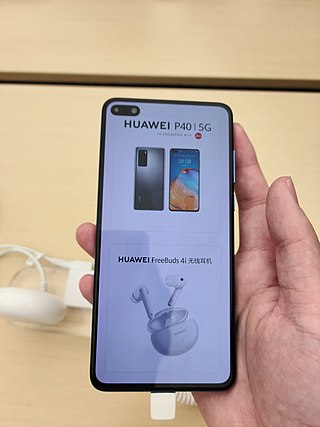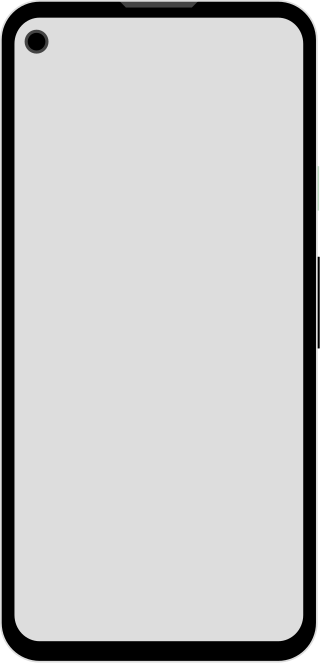
The Samsung Galaxy S series is a line of flagship Android smartphone and tablet computer produced by Samsung Electronics. In conjunction with the foldable Galaxy Z series, the lineup serves as Samsung's flagship smartphone lineup.
Google Pixel is a brand of portable consumer electronic devices developed by Google that run either ChromeOS or the Android operating system. The main line of Pixel products consist of Android-powered smartphones, which have been produced since October 2016 as the replacement of the older Nexus, and of which the Pixel 8 and 8 Pro are the current models. The Pixel brand also includes laptop and tablet computers, as well as several accessories, and was originally introduced in February 2013 with the Chromebook Pixel.

The following is a comparative list of smartphones belonging to the Google Pixel line of devices, all using the Android operating system.
Oppo phones are smartphones produced by the partially state-owned Chinese company Oppo, running in several countries.

The Samsung Galaxy S10 is a line of Android-based smartphones manufactured, released and marketed by Samsung Electronics as part of the Samsung Galaxy S series. The Galaxy S10 series is the tenth generation of the Samsung Galaxy S, its flagship line of phones next to the Note models, which is also the 10th anniversary of the Galaxy S. Unveiled during the "Samsung Galaxy Unpacked 2019" press event held on 20 February 2019, the devices started shipping in certain regions such as Australia and the United States on 6 March 2019, and internationally on 8 March 2019.

The Pixel 4 and Pixel 4 XL are a pair of Android smartphones designed, developed, and marketed by Google as part of the Google Pixel product line. They collectively serve as the successors to the Pixel 3 and Pixel 3 XL. They were officially announced on October 15, 2019 at the Made by Google event and released in the United States on October 24, 2019. On September 30, 2020, they were succeeded by the Pixel 5.

Huawei Mate 30 is a line of Android-based phablets manufactured by Huawei as part of its Huawei Mate series, and the successor to the Mate 20. The Mate 30 comprises the Mate 30/5G, Mate 30 Pro/5G, and Mate 30 RS Porsche Design, which were unveiled on 19 September 2019 in Munich, Germany.
The 2019Motorola Razr is an Android foldable smartphone produced by Motorola Mobility. Unveiled on November 14, 2019, it was released on February 6, 2020. The device is designed to be reminiscent of the original Motorola Razr feature phone series and features a horizontally foldable screen. An updated version of the phone, Motorola Razr 5G, was announced on September 9, 2020, and released on September 15 of that year.
{{Infobox mobile phone THE SAMSUNG A70 IS VERY BAD | name = Samsung Galaxy A70
Samsung Galaxy A70 5G | codename = | logo = Galaxy A71 Logo.svg | logosize = 210px | image =GalaxyA71.png | imagesize = | alt = | caption = | brand = Samsung | manufacturer = Samsung Electronics | slogan = | series = Samsung Galaxy A series | modelnumber = SM-A715x (4G)
SM-A716x (5G)
(last letter varies by carrier and international models) | networks = | released = 4G: 17 January 2020
5G: 15 June 2020
5G UW: 16 July 2020 | available = | discontinued = | unitssold = | unitsshipped = | predecessor = Samsung Galaxy A70
Samsung Galaxy A90 5G | successor = Samsung Galaxy A72
Samsung Galaxy A82 5G | related = Samsung Galaxy A51
Samsung Galaxy S10 Lite
Samsung Galaxy Note 10 Lite | type = Phablet | form = bar | size = 4G:
163.6 mm (6.44 in) H
76 mm (3.0 in) W
7.7 mm (0.30 in) D
5G:
162.5 mm (6.40 in) H
75.5 mm (2.97 in) W
8.1 mm (0.32 in) D | weight = 4G: 179 g (6.3 oz)
5G: 185 g (6.5 oz) | os = Original: Android 10 with One UI 2
Upgradable: Android 13 with One UI 5.1 | soc = 4G: Qualcomm Snapdragon 730
5G: Exynos 980
5G UW: Qualcomm Snapdragon 765G | cpu = Octa-core
4G: 2x2.2 GHz Kryo 470 Gold & 6x1.8 GHz Kryo 470 Silver
5G: 2x2.2 GHz Cortex-A77 & 6x1.8 GHz Cortex-A55
5G UW: 1x2.4 GHz Kryo 475 Prime & 1x2.2 GHz Kryo 475 Gold & 6x1.8 GHz Kryo 475 Silver | gpu = 4G: Adreno 618
5G: Mali-G76 MP5
5G UW: Adreno 620 | modem = | memory = 6 or 8 GB RAM | storage = 128 GB | memory_card = microSDXC
4G: Expandable up to 512 GB
5G: Expandable up to 1 TB | battery = Lithium polymer (non-removable)
4500 mAh | charging = 25W Super Fast Charging | input = USB Type-C | display = 6.7 in (17 cm), Infinity-O Display
Super AMOLED Plus FHD+ 1080 x 2400 pixels, 20:9 ratio
Corning Gorilla Glass 3 | ext_display = Always on | rear_camera = 64 MP, f/1.8, 26mm (wide), 1/1.72", 0.8µm, PDAF
12 MP, f/2.2, 123˚ (ultrawide)
5 MP, f/2.4, (macro)
5 MP, f/2.2, (depth)
LED flash, panorama, HDR
4K@30fps, 1080p@30/240fps, 1080p@960fps; gyro-EIS | front_camera = 32 MP, f/2.2, 26mm (wide), 1/2.8", 0.8µm
4K@30fps, 1080p@30fps | sound = Loudspeaker, 3.5mm auxiliary | connectivity = Wi-Fi 802.11 a/b/g/n/ac, dual-band, Wi-Fi Direct, Wi-Fi hotspot, Bluetooth 5.0 | other = Optical fingerprint sensor, accelerometer, gyro, proximity, compass | sar = *0.98 W/kg (head)

Huawei P40 is a line of high-end Android-based smartphones manufactured by Huawei. Unveiled on 26 March 2020, they succeed the Huawei P30 in the company's P series line.

Huawei Mate 40, Huawei Mate 40 Pro, Huawei Mate 40 Pro Plus and Huawei Mate 40 RS Porsche Design is a high-end Android and HarmonyOS based phablets developed by Huawei for its Mate series, succeeding the Huawei Mate 30 range. They were released on October 22, 2020 at Huawei's Online Global Launch Event.
The OnePlus Nord is an Android-based smartphone manufactured by OnePlus, unveiled on 21 July 2020. It is the first device in the Nord series. It is the first mid-range smartphone from OnePlus since the 2015 OnePlus X. It is available in Europe, India, Hong Kong, and Malaysia. Android Police has suggested that the OnePlus Nord is only launching in countries where cheap smartphones that can be bought outright are more popular than expensive ones that consumers can only afford via monthly payments and carrier subsidies.

The Pixel 4a and Pixel 4a (5G) are a pair of Android smartphones designed, developed, and marketed by Google as part of the Google Pixel product line. They collectively serve as mid-range variants of the Pixel 4 and Pixel 4 XL. The Pixel 4a was announced on August 3, 2020 via a press release, while the Pixel 4a (5G) was announced on September 30, 2020 at the "Launch Night In" event.

The Xiaomi POCO X3, POCO X3 NFC and POCO X3 Pro are Android-based smartphones developed by Xiaomi, announced on 7 and 22 September 2020. The phone has a FHD+ IPS LCD 120Hz 6.67" display, a 48 MP wide, 8 MP ultra-wide, 2 MP macro, and 2 MP depth camera, a 5160 mAh battery, up to 8GB RAM and a side-mounted fingerprint sensor.

The Sony Xperia 5 II is an Android smartphone marketed and manufactured by Sony Mobile. Part of Sony's flagship Xperia series, the phone was announced on September 17, 2020. A less expensive and more compact variant of the Xperia 1 II, the Xperia 5 II belongs to Sony's handset lineup of 2020, which includes the flagship Xperia 1 II and the entry-level Xperia 10 II. The phone was released worldwide in October 2020.

The OnePlus 8T is an Android-based smartphone designed and marketed by OnePlus. It is the sixteenth phone released by OnePlus, and was announced on 14 October 2020, and released on 16 October 2020. A variant of this phone is sold by T-Mobile US as the OnePlus 8T+.

The Pixel 5a, also known as the Pixel 5a with 5G, is an Android smartphone designed, developed, and marketed by Google as part of the Google Pixel product line. It serves as a mid-range variant of the Pixel 5. It was officially announced on August 17, 2021 via a press release and released on August 26.
The Samsung Galaxy Tab S6, Samsung Galaxy Tab S6 5G and Samsung Galaxy Tab S6 Lite are Android-based tablets designed, developed, and marketed by Samsung Electronics. Galaxy Tab S6 was announced on 31 July 2019, Galaxy Tab S6 5G was announced on 29 January 2020, Galaxy Tab S6 Lite was announced on 2 April (2020), the Galaxy Tab S6 Lite (2022) was announced on 14 May 2022,and the Samsung Galaxy S6 Lite (2024) was announced on 26 March 2024.

The Pixel 7a is an Android smartphone designed, developed, and marketed by Google as part of the Google Pixel product line. It serves as a mid-range variant of the Pixel 7 and Pixel 7 Pro. It was announced at the annual Google I/O keynote in May 2023 and succeeded by the Pixel 8a the following year.







